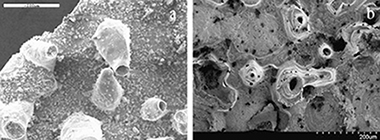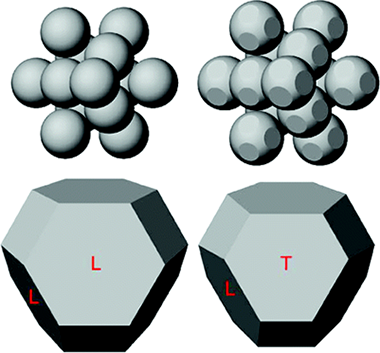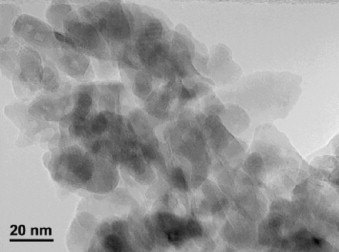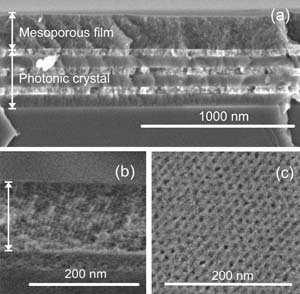Artículos SCI
2009
2009
Hg/Sn amalgam degradation of ancient glass mirrors
Herrera, LK; Duran, A; Franquelo, ML; Justo, A; Perez-Rodriguez, JLJournal of Non-Crystalline Solids, 355 (2009) 1980-1983
Show abstract ▽

Tin amalgam, which is obtained by pouring mercury onto a sheet of tin, has been used in the production of reflective coatings for mirrors. The corrosion processes of the amalgam layer were investigated in several mirrors from historical buildings located in southern Spain using SEM/EDS, XPS, and GID. Mercury and Sn4+ are present as spheres on the amalgam surface due to the evaporation process (∼5 nm). The profile shows a mixture of Sn2+ and Sn4+. The original amalgam was composed of a binary alloy of tin and mercury (Hg0.1Sn0.9) and metallic tin. In this paper the tin oxidation mechanism of the amalgam is described. Liquid mercury is volatile and evaporates slowly, leaving fine tin particles that oxidize easily, forming tin monoxide (SnO) and tin dioxide (SnO2). The mercury-rich phase accelerates the corrosion of the tin-rich phase.
Octubre, 2009 | DOI: 10.1016/j.jnoncrysol.2008.11.045
Materiales Ópticos Multifuncionales
Optical Analysis of the Fine Crystalline Structure of Artificial Opal Films
Lozano, G; Dorado, LA; Schinca, D; Depine, RA; Miguez, HLangmuir, 25 (2009) 12860-12864
Show abstract ▽

Herein, we present a detailed analysis of the structure of artificial opal films. We demonstrate that, rather than the generally assumed face centered cubic lattice of spheres, opal films are better approximated by rhombohedral assemblies of distorted colloids. Detailed analysis of the optical response in a very wide spectral range (0.4 ≤ a/λ ≤ 2, where a is the conventional lattice constant), as well as at perpendicular and off-normal directions, unambiguously shows that the interparticle distance coincides very approximately with the expected diameter only along directions contained in the same close-packed plane but differs significantly in directions oblique to the [111] one. A full description of the real and reciprocal lattices of actual opal films is provided, as well as of the photonic band structure of the proposed arrangement. The implications of this distortion in the optical response of the lattice are discussed.
Octubre, 2009 | DOI: 10.1021/la903077r
Química de Superficies y Catálisis - Materiales Nanoestructurados y Microestructura
Manganese and iron oxides as combustion catalysts of volatile organic compounds
Duran, FG; Barbero, BP; Cadus, LE; Rojas, C; Centeno, MA; Odriozola, JAApplied Catalysis B-Environmental, 92 (2009) 194-201
Show abstract ▽

FeMn mixed oxides were prepared by the citrate method with Fe:Mn atomic ratio equal to 1:1, 1:3 and 3:1. The sample was characterized by means of specific surface area measurements, X-ray diffractometry (XRD), temperature programmed desorption of oxygen (O2-DTP), temperature programmed reduction (TPR), X-ray fluorescence (XRF), transmission electron microscopy (TEM and SAED) and high resolution TEM (HREM). The characterization results demonstrated the formation of a Mn2O3–Fe2O3 solid solution. The catalytic performance in ethanol, ethyl acetate and toluene total oxidation on these samples was better than on Fe2O3 and Mn2O3 pure oxides.
Octubre, 2009 | DOI: 10.1016/j.apcatb.2009.07.010
Materiales Nanoestructurados y Microestructura
Vibrational spectroscopy characterization of magnetron sputtered silicon oxide and silicon oxynitride films
Godinho, V; Denisov, VN; Mavrin, BN; Novikova, NN; Vinogradov, EA; Yakovlev, VA; Fernandez-Ramos, C; de Haro, MCJ; Fernandez, AApplied Surface Science
Show abstract ▽

Vibrational (infrared and Raman) spectroscopy has been used to characterize SiOxNy and SiOx films prepared by magnetron sputtering on steel and silicon substrates. Interference bands in the infrared reflectivity measurements provided the film thickness and the dielectric function of the films. Vibrational modes bands were obtained both from infrared and Raman spectra providing useful information on the bonding structure and the microstructure (formation of nano-voids in some coatings) for these amorphous (or nanocrystalline) coatings. X-ray photoelectron spectroscopy (XPS) and scanning electron microscopy (SEM) analysis have also been carried out to determine the composition and texture of the films, and to correlate these data with the vibrational spectroscopy studies. The angular dependence of the reflectivity spectra provides the dispersion of vibrational and interference polaritons modes, what allows to separate these two types of bands especially in the frequency regions where overlaps/resonances occurred. Finally the attenuated total reflection Fourier transform infrared measurements have been also carried out demonstrating the feasibility and high sensitivity of the technique. Comparison of the spectra of the SiOxNy films prepared in various conditions demonstrates how films can be prepared from pure silicon oxide to silicon oxynitride with reduced oxygen content.
Octubre, 2009 | DOI: 10.1016/j.apsusc.2009.07.101
Materiales Ópticos Multifuncionales
Mesostructured Thin Films as Responsive Optical Coatings of Photonic Crystals
Hidalgo, N; Calvo, ME; Miguez, HSmall, 5 (2009) 2309-2315
Show abstract ▽

A synthetic route is presented to attain high-optical-quality multilayered structures that residtfront coupling ordered n7esoporous tilaniuni oxide thin films to the surface of a dense one-dimensional photonic crystal. Such architectures present spectrally well-defined photon resonant modes localized in the outer coating that finely respond to physicochemically induced modifications of its pore volume. The potential of these porous coatings in detection of environmental changes through variations of the photonic response of the ensemble is demonstrated by performing isothermal optical reflectance measurements under controlled vapor-pressure conditions.
Octubre, 2009 | DOI: 10.1002/smll.200900411
- ‹ anterior
- 390 of 422
- siguiente ›














